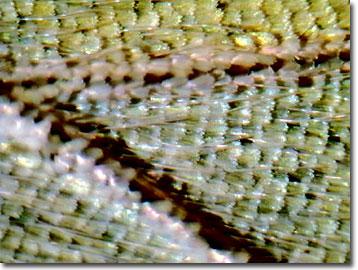Butterfly Wing Scale Digital Image Gallery
Leopard Lacewing Butterfly
Adult leopard lacewings gather energy for flight and reproduction from the nectar of various flower species, such as lantana. Frequently observed in tropical and subtropical forests, during the rainy season leopard lacewing numbers increase dramatically. Hundreds of the butterflies may fly en masse, creating an amazing spectacle.

Sometimes alternatively referred to as the red or Malay lacewing butterfly, this dazzling insect exhibits strong sexual dimorphism. Females feature wing patterns with a gray or white background, whereas the upper surfaces of the males are a bright orange, yellow, or red. Both sexes are sprinkled with blackish-blue spots and lining veins. The butterflies are somewhat camouflaged when at rest because duller earth tones are featured on the undersurfaces of their wings.
The leopard lacewing butterfly, which is scientifically known as Cethosia cyane, ranges from India, throughout Southeast Asia, into the islands of Malaysia and Indonesia, and south to Papua New Guinea. Two subspecies are described, one from India, Bhutan and Burma, and the other from northern Thailand and Indo-China. Somewhat adaptable to human disturbance, leopard lacewing butterflies are sometimes found in gardens and along road right-of-ways in populated areas.
The caterpillars of the lacewing butterfly feed on the leaves of flowering vines in the genus Passiflora. Similar to many other butterflies that feed on passion vines, leopard lacewing larvae ingest and sequester defensive phytochemicals from the plant. Consequently, the larvae and adult butterflies display a distinct warning coloration that advertises their unpalatable nature to potential predators. When handled, these tropical lepidopterans often exude a noxious odor generated from the ingested passion vine organic compounds.
Collection pressures, destruction of tropical rainforests, climatic changes, and rampant use of pesticides have caused problems for leopard lacewings in some localities. Additionally, many years of war and agricultural production have removed much of the butterfly’s original habitat and damaged natural populations. A growing interest in ecotourism and butterfly watching, however, shows promise of preservation and possible restoration of some of this beautiful lepidopteran's crucial ecosystem.
Contributing Authors
Cynthia D. Kelly, Shannon H. Neaves, Laurence D. Zuckerman, and Michael W. Davidson - National High Magnetic Field Laboratory, 1800 East Paul Dirac Dr., The Florida State University, Tallahassee, Florida, 32310.
BACK TO THE BUTTERFLY WING SCALE IMAGE GALLERY
BACK TO THE DIGITAL IMAGE GALLERIES
Questions or comments? Send us an email.
© 1995-2022 by Michael W. Davidson and The Florida State University. All Rights Reserved. No images, graphics, software, scripts, or applets may be reproduced or used in any manner without permission from the copyright holders. Use of this website means you agree to all of the Legal Terms and Conditions set forth by the owners.
This website is maintained by our
Graphics & Web Programming Team
in collaboration with Optical Microscopy at the
National High Magnetic Field Laboratory.
Last Modification Friday, Nov 13, 2015 at 02:19 PM
Access Count Since January 21, 2003: 9264
Visit the website of our partner in introductory microscopy education:
|
|
